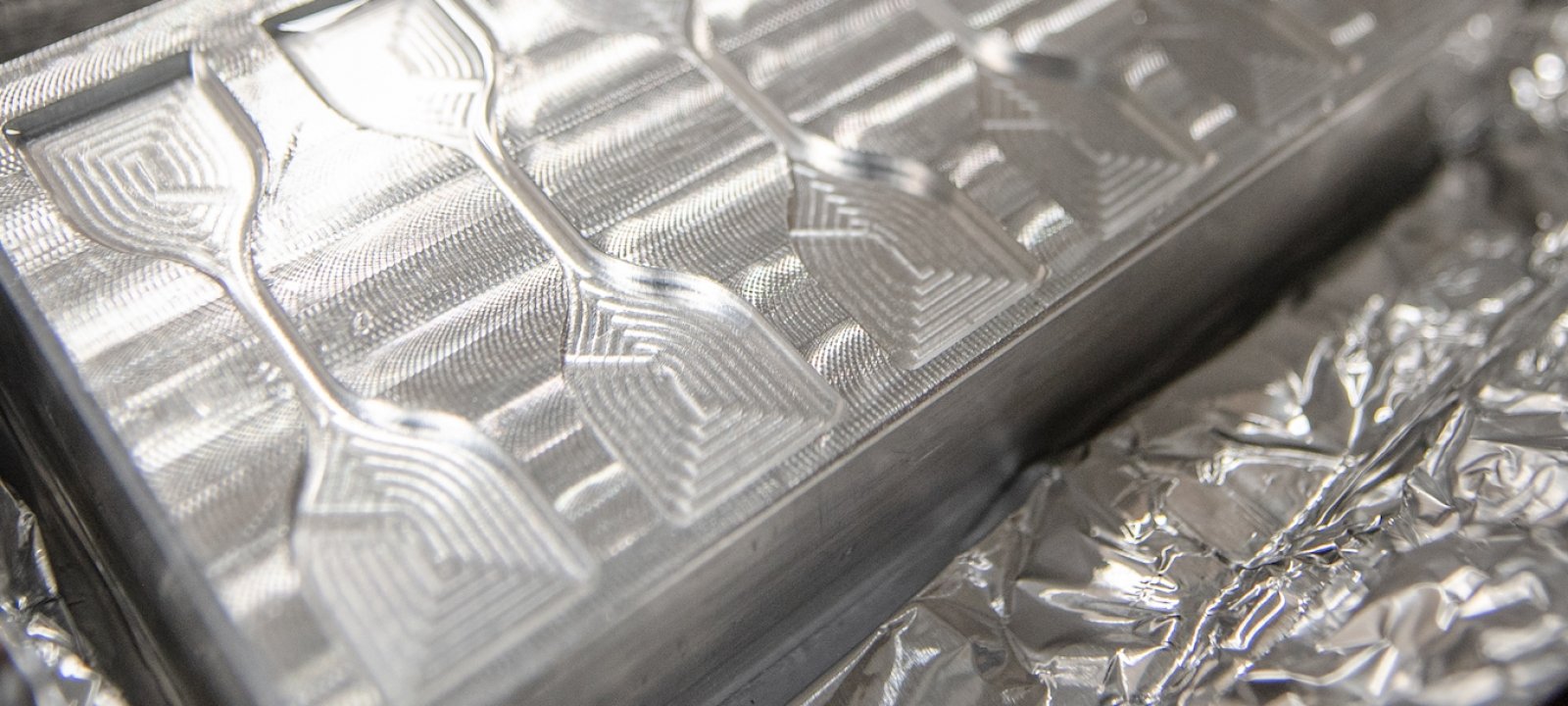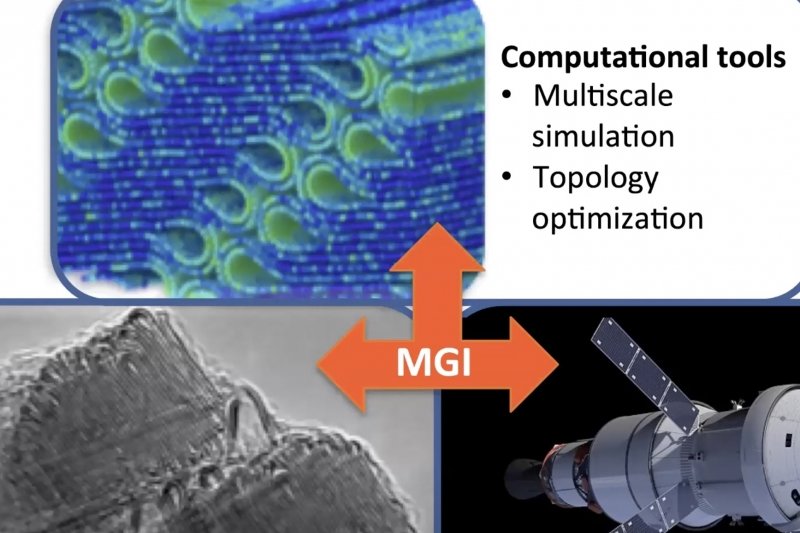The Mechanics of Multi-scale Materials research group uncovers the relationships of
structures across the full range of engineering scales, from the molecular to the
macro.
In addition to established practices of nano-scale modeling and large-scale structural
mechanics, the group is bridging the gap between these scales by developing accurate
constitutive modeling and characterization of each intermediate level.
Uncovering how the nano- and micro-level mechanics play into the millimeter- and meter-level
structures enables advanced composite materials to be optimized for structural performance.
Through advanced multi-scale modeling, simulation, and experimentation, research is
focused on developing methods that will inform emerging technologies including nano-,
micro-, and biomedical engineering and science. This research group is well positioned
to advance this rapidly emerging field.
Tomorrow Needs Novel Materials
Research activities include identifying the critical parameters that lead to the success
or failure of material for a particular application
We work to model structural foam designs for aerospace and automotive products, with
the goal of improving thermal insulation, impact absorption, and moment of inertia.
As functions of intermediate scales between the nano and macro are characterized,
novel materials and composites can be created and optimized. Researchers are working
on novel experiments, MEMS/NEMS, atomistic and continuum modeling, multifunction materials
and devices, microfluidic, tissue engineering, nanostructured material, material characterization,
biological transport, cell mechanics, and physics-based modeling.
The Complex Fluids and Active Matter Lab addresses a fascinating class of problems in contemporary fluid mechanics that involves
the interplay between dynamic boundaries and fluid flows. The study of these problems
usually requires accommodating several time and length scales.
The Mechanics, Acoustics, and Dynamics Lab (MADLab) is an engineering research lab focused on understanding the fundamental
mechanics of advanced structured material systems and leveraging this understanding
to create new technologies for aerospace and mechanical applications.
The Mechanics and Modeling of Advanced Materials Lab involves such topics as multiscale, multiphysics modeling of aging in polymers and
polymer composites.
The Michigan Tech Aerospace Engineering Research Center (MARC) involves such research as multiscale modeling of advanced fiber-reinforced
thermoset composites.
The Planetary Surface Technology Development Lab (PSTDL) develops technology solutions for planetary surface exploration of the Moon,
Mars, and beyond while training the next generation of engineers.
Faculty + Research = Discovery
Our department boasts world-class faculty who have access to numerous innovative research
labs and are committed to discovery and learning.
This encompasses a range of research areas, experiences, and expertise related to
the mechanics of multi-scale materials. Learn more about our faculty and their research
interests:
Use of severe plastic deformation to alter properties of materials; Failure studies of random fiber composites; Nanoscale properties of interphase in polymer matrix composites; Photomechanics integrated with digital image processing for stress analysis
Computational Mechanics; Computational Materials Science; Computational Chemistry
Multiscale, multiphysics modeling of aging in polymers & polymer composites; Degradation of metallic implants in physiological environment; Fracture, damage and impact behavior on materials; Analysis, design and testing of novel multifunctional lightweight polymer composite materials
Acoustic and Elastic Metamaterials; Cellular Structures; Advanced and Additive Manufacturing; Vibration and Modal Analysis; Elastic Wave Propagation; Multiphysics Modeling; Inflatable Structures
Extreme Environment Technologies (Space, Underwater, Mining, Arctic, etc.); Excavation and Mining Technology; Planetary Science and Exploration; In-Situ Resource Utilization; Space Mining and Construction; Design Optimization; Robotics and Automation; System Engineering and Integration
Computational fluid dynamics (CFD); Modeling and numerical simulation of diesel particulate trap (DPF) performance during loading and regeneration; Diesel oxidation catalyst (DOC) converter code development; Lattice Boltzmann Method for Porous/Disordered Media
Research Projects
Our faculty engage in a number of research projects, many of which are publicly funded.
A sample listing of recent research projects appears below. You can also view a broader
list of research projects taking place across the mechanical engineering-engineering mechanics department.
Past Projects
Developing and Deploying Thin Wall Ductile Iron Casting for High Volume Production
Project Executive Summary:
The ability to cast thin wall ductile iron (DI) castings is critical to leveraging the high stiffness and strength of these materials. Current components often have section sizes thicker than dictated by mechanical requirements due to process and material limitations. By implementing improved methods and alloys, there is potential to decrease wall thicknesses by 50%, thus enabling lightweighting of transportation components by 30%-50% depending on component loading. In addition to geometry optimization, some thin wall applications have shown 10% higher strengths and 100% more elongation compared to standard chemistries and wall thicknesses. This project will focus initially on vertical green sand molding, in which wall thicknesses could be reduced from 3 mm to 1.5 mm. Similar reductions are possible with other molding techniques such as horizontal green sand molding from 6 mm to 2 mm, and the lost foam process from 4 mm to 1.5 mm.
High volume production of thin wall DI castings presents challenges in both metallurgy and processing.
- DI alloys will need better inoculation practice to control graphite morphology and matrix structure
- Pearlitic and high silicon, ferritic ductile iron alloys (MRL 4) will be used; compositions may need to be optimized to avoid carbides
- Sand molding dimensional capability and surface finish require improvement; heat transfer may need better control.
- Given the thinner walls, shakeout, finishing, machining, and heat treatment processes will have to be fine-tuned
- In addition to the above manufacturing considerations, design engineers will need updated design rule for thin wall DI castings to take advantage of this lightweighting opportunity. A component case study will be used to quantify weight save.
This project will focus on the manufacturing process development required to bring thin wall, vertical green sand molded DI castings to high volume production. All parts of the process denoted above have been previously developed; this project will integrate these into a capable production system. After successful implementation, this knowledge will be transferred to horizontal and lost foam molding processes.
Revealing the Inside of a Nanoscale Na-ion Battery: New Understanding on Sodium Intercalation in Cathodes
Introduction
While tremendous research is focused on lithium-ion batteries worldwide, scientific challenges associated with room-temperature rechargeable sodium-ion batteries, the next alternative for Li-batteries, have been relatively unexplored. These challenges are much more complicated than the Li-ion case. Na+ is larger than Li+ by 70%, which induces huge mechanical stresses upon driving the Na-ion into the host electrode. Na+ is chemically more reactive than Li, thus, sodium intercalation triggers multiphase reactions that remain to be identified. The sodium intercalation/ deintercalation process, therefore, leads to series of coupled electrochemically-driven mechanical instabilities, electrical conductivity degradation, and complex phase transformations that reduce the battery life drastically. In spite of this scientific complexity, a glance through the list of active awards in NSF website shows that there have been more than 30 recent awards to
Li-ion battery research while this has been almost none for Na-ion batteries. Thus, the field of room-temperature rechargeable Na-ion battery research is thriving for federal support to overcome these obstacles and make a viable alternative technology to Li-ion batteries. This is of prime importance considering that Li resources are very limited and their price has increased continuously during the past 20 years.
The objective of this research is to understand the underlying mechanisms behind the Na intercalation/ deintercalation in cathode electrodes and tailoring the electro-mechanical degradation of cathodes in nanoscale rechargeable Na-ion battery cell. The nano-battery is composed of ionic liquids as electrolyte, anode (Na metal), and cathode (manganese oxide nanowires). The manganese oxide electrode will be subjected to electrochemical probing using a conductive atomic force (AFM) and scanning tunneling microscopy (STM) that operate inside transmission electron microscope (TEM). The proposed research project aims to bring new ideas and momentum to the field of Na-ion battery research.
Intellectual Merit:
The in-situ studies will enable research in four relatively unexplored fields: (i) The correlation of failure instabilities and loss of electrical conductivity with multi-phase transformations induced by sodiation/ desodiation; (ii) The role of diameter (surface effect) and crystallography of host electrodes on Na-ion intercalation/ deintercalation mechanisms; and (iv) Investigating the Na-dendrite fiber formation and possible safety concerns. The new understanding can facilitate the design of safer and higher capacity cathode electrodes in future rechargeable Na-ion batteries.
The experimental methodology and protocols to analyze the data are not limited to manganese oxide nanowires and can be extended to other nanomaterials (both for anodes and cathodes) to enable new technologies in rechargeable Na-ion batteries.
New Insights on High Performance Anodes for Lithium-Ion Batteries
Abstract:
To obtain a noticeable improvement in the specific capacity of current Li-ion batteries (graphite anodes, capacity of 372 mAhg-1), it is essential to increase the capacity of the anodes. The most attractive candidate is silicon which has the highest known capacity, in excess of 4000 mAhg-1. A major drawback with silicon is that upon driving Li into Si, large mechanical stresses develop in Si that lead to fracture and pulverization of Si and, eventually, capacity fade. It appears that the mechanistic and structural details regarding the lithiation/ delithiation degradation of Si nanostructures are not well understood. This research aims to fill this gap.
The objectives are to understand:
(i) The pulverization mechanics and the correlation with LixSi phase transformations in Si NRs;
(ii) The role of size-scale and crystallography on Li insertion/ extraction;
(iii) Degradation of =rent collector-NR interface during lithiation/ delithiation cycles.
The Li insertion/ extraction studies conducted in real time by using a novel in-situ electrochemical setup that operates inside a chamber of a transmission elech•on microscope (TEM). Ionic liquids are used as the Li-enriched media and nanorods are subjected to electrical potential using a scanning probe microscopy (STM and AFM) inside TEM. The mechanics of lithiated/ delithiated NRs and the strength of their interface with current collector is also being studied. The experimental methodology and protocols to analyze the data are not limited to Si nanorods and can be extended to other nanomaterials with potential to be used as anodes in lithium-ion batteries.


